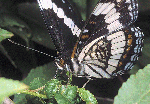
Utah Lepidopterists' Society
Founded 6 Nov 1976

|
|
Utah Lepidopterists' Society Founded 6 Nov 1976 |
|
| History | Mission | Meetings | Bulletin | Checklists | Links | Community | Field Trips | Habitat | Members | Kids | Contact Us |
Volume 5 - No. 2, October 1995
ULS Offers Support for Hogle Zoo Butterfly World
On 15 Feb 1995, ULS members Jack Harry, Ray Evenson, and Todd Stout met with Hogle Zoo Director Lamar Farnsworth and General Curator Kimberly Davidson in order to consult the zoo on the upcoming Butterfly World Exhibit to be opening later that summer.
The intent of the meeting was to discuss what species of butterflies might be available for such an exhibit, what Utah butterflies might be suitable, and what precautions the zoo should take to see to the well being of live butterflies. The issue of butterfly life histories was also brought up as Lamar and Kimberly were curious as to which species of Utah butterflies could be successfully raised in the exhibit so that passers by could possibly witness their life history. The intent was to have zoo employees seek out butterfly immatures in nearby canyons.
The consensus of the three ULS consultants is that the Hogle Zoo should contact Butterfly World in Coconut Creek, Florida (Fort Lauderdale) to see what species of butterflies adapt best to a "closed" environment and what their concerns were. At the same time, Jack recommended that Lamar purchase "Butterflies of North America" by Jim Scott as a good initial reference for butterfly identification and taxonomy. Ray recommended which commercial butterfly livestock sources might accommodate the zoo, and Todd committed to writing a summary of recommendations from all three consultants.
Todd later wrote Lamar and Kimberly on 1 Mar 1995 and, in a nutshell, recommended that the Zoo pick up copies of Butterflies of the Rocky Mountain States by Ferris and Brown as well as Weeds of the West by Whitson for identification and taxonomy. He also introduced them to Bioquip as a good general source for lepidoptera supplies. Todd also discussed basic rearing techniques and recommended local stores for containers, terrariums, and so forth.
On 10 Jun 1995, after several months of
dedicated planning by Director Lamar Farnsworth and General Curator Kimberly
Davidson, Hogle Zoo introduced Butterfly World to the public. Since its
opening, thousands of impressed Zoo spectators have passed through with nothing
but praise and wonder for Butterfly World.
The Zoo's marketing officials did a
fine job of introducing Butterfly World by announcing its opening through local T.V. and
Newspapers as well as putting up billboards (see lower right) all over town.
|
|

|

|
|
Setting aside the option of rearing and capturing local butterflies, Farnsworth opted to purchase butterfly pupae of North American species from any of three Florida vendors. The species flying at Butterfly World this summer are as follows: Battus philenor, Battus polydamas, Papilio cresphontes, Papilio palamedes, Papilio troilus, Papilio polyxenes, Phoebis philea, Eurema nicippe, Phoebis sennae, Agraulis vanillae, Anartia jetrophae, Limenitis archippus floridensis, Dryas julia, Heliconius charitonius, Danaus gilippus, Danaus plexippus, Marpesia petreus, Polygonia comma, Polygonia interrogationis, Siproeta stelenes, and Vanessa cardui.
 Passers through Butterfly World seem most interested with the Emerging Box
where received pupae from Florida are prepared by Gina and Chris to hang until
they enclose. Oddly enough spectators keep asking, "Are those alive?"; even
though the sign above the Emerging Box says, "Live Chrysalis."
Passers through Butterfly World seem most interested with the Emerging Box
where received pupae from Florida are prepared by Gina and Chris to hang until
they enclose. Oddly enough spectators keep asking, "Are those alive?"; even
though the sign above the Emerging Box says, "Live Chrysalis."
One of the more intriguing aspects of Butterfly World is how differently certain species have adapted to this indoor facility. Although fond of nectar sources like Buddleia and Lantana, Upper Sonoran species such as Danaus plexippus and Vanessa cardui seemed to spend their free time on the window wells trying to escape rather than adapting to their environment. This is not too much of a surprise considering that both of these species are highly wary and migratory. What was puzzling was that localized Lower Sonoran species such as Limenitis archippus floridensis and Siproeta stelenes also seemed to scheme with the Monarchs and Painted Ladies in attempting to escape. (Ironically, one wild, local Papilio rutulus was spotted trying to enter Butterfly World from the outside.)
 On the other hand, Sub-tropical species like Battus polydamas, Battus
philenor, Phoebis philea, Papilio cresphontes, and Anartia jetrophae
adapted very well to the exhibit. These species were often seen mating as
well as spending a lot of time flying around and nectaring on flowers.
On the other hand, Sub-tropical species like Battus polydamas, Battus
philenor, Phoebis philea, Papilio cresphontes, and Anartia jetrophae
adapted very well to the exhibit. These species were often seen mating as
well as spending a lot of time flying around and nectaring on flowers.
In fact, the Zebra Longwing, Heliconius charitonius, seemed to be the most well-adapted and visibly aesthetic of all the rest of the butterflies. Dozens of Zebras could be seen at any given moment gayly flying around the tops and through the Ficus trees as if they owned the place. What a sight to behold! Gina Phillips agreed; jokingly stating that next year Butterfly World ought to exclusively order charitonius and call the exhibit, "Zebra World." If it weren't for the potential confusion between the Zebra Longwing and the black and white striped horse from Africa, the Hogle Zoo just might have considered it.
Todd L. Stout--Editor
All images of Limenitis weidemeyeri on the ULS Info Bar courtesy Jay Cossey